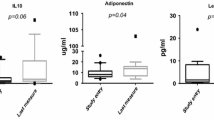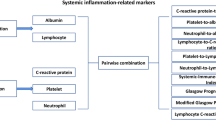Abstract
We wanted to investigate the possible etiologic factors of cachexia. Forty-six patients diagnosed with cancer cachexia and 34 healthy controls were included in the study. Serum total testosterone, free testosterone, interleukin 1 (IL) alpha and beta, IL6, tumor necrosis factor (TNF) alpha, orexin, galanin, neuropeptide Y, tumor necrosis factor-like weak inducer of apoptosis and tumor necrosis factor receptor-associated factor 6, and C-reactive protein (CRP) levels were investigated. There were 36 male and 10 female patients in the cachexia group, and 24 male and 10 female patients in the control group. Median overall survival (OS) of the cachexia group after the diagnosis of cachexia was 8 (1–25) months. There were statistically significant relationships between OS and BMI, serum CRP, TRAF-6, albumin, and LDH levels in the cachexia group. In addition to cachexia, serum CRP, testosterone, and TNF alpha levels were statistically significantly correlated with OS in refractory cachexia. TRAF-6 levels was significantly correlated with type of cancer (P = 0.02). Although cachexia presents with a multifactorial ethio-pathogenesis, few of them affect the OS. Our novel results were that serum CRP, albumin, LDH, and TRAF-6 levels have a higher association with OS in patients with cancer cachexia compared to the many other parameters. An ongoing cachexia also called refractory cachexia is a recent definition. This end-stage term of cancer duration may be predicted by decreasing serum testosterone and increasing serum TNF alpha levels, as well as serum CRP levels.

Similar content being viewed by others
References
Wanger T, Foster NR, Nguyen PL, Jatoi A. Patients’ rationale for declining participation in a cancer-associated weight loss study. J Cachexia Sarcopenia Muscle. 2014;5:121–5.
Ravasco P, Monteiro-Grillo I, Vidal PM, Camilo ME. Nutritional deterioration in cancer: the role of disease and diet. Clin Oncol. 2003;15:443–50.
Dewys WD, Begg C, Lavin PT, et al. Prognostic effect of weight loss prior to chemotherapy in cancer patients. Am J Med. 1980;69:491–7.
Ikeda T, Nishiguchi Y, Chung Y, Yamada N, Sowa M. Experimental study of the effect of IL-6 on cancer cachexia. Oncol Rep. 1997;4:921–6.
Tan BH, Deans DA, Skipworth RJ, Ross JA, Fearon KC. Biomarkers for cancer cachexia: is there also a genetic component to cachexia? Support Care Cancer. 2008;16:229–34.
Mahmoud FA, Rivera NI. The role of C-reactive protein as a prognostic indicator in advanced cancer. Curr Oncol Rep. 2002;4:250–4.
Falconer JS, Fearon KC, Ross JA, et al. Acute-phase protein response and survival duration of patients with pancreatic cancer. Cancer. 1995;75:2077–782.
Wallengren O, Lundholm K, Bosaeus I. Diagnostic criteria of cancer cachexia: relation to quality of life, exercise capacity and survival in unselected palliative care patients. Support Care Cancer. 2013;21:1569–77.
McMillan DC, Watson WS, O’Gorman P, et al. Albumin concentrations are primarily determined by the body cell mass and the systemic inflammatory response in cancer patients with weight loss. Nutr Cancer. 2001;39:210–3.
Gupta D, Lis GC. Pretreatment serum albumin as a predictor of cancer survival: a systematic review of the epidemiological literature. Nutr J. 2010;9:69.
Plewka A, Madej P, Plewka D, et al. The TRAF2 and TRAF6 expression in myomas and myometrium of women in reproduction and perimenopausal age. Folia Histochem Cytobiol. 2010;48:407–16.
Baracos VE. Cancer-associated cachexia and underlying biological mechanisms. Annu Rev Nutr. 2006;26:435–61.
Sun YS, Ye ZY, Qian ZY, Xu XD, Hu JF. Expression of TRAF6 and ubiquitin mRNA in skeletal muscle of gastric cancer patients. J Exp Clin Cancer Res. 2012;31:8.
Paul PK, Gupta SK, Bhatnagar S, et al. Targeted ablation of TRAF6 inhibits skeletal muscle wasting in mice. J Cell Biol. 2010;191:1395–411.
Cağlar K, Kutluk T, Varan A, et al. Leptin and neuropeptide Y plasma levels in children with cancer. J Pediatr Endocrinol Metab. 2005;18:485–9.
Kowalczuk A, Wiecek A, Franek E, Kokot F. Plasma concentration of leptin, neuropeptide Y and tumor necrosis factor alpha in patients with cancers, before and after radio- and chemotherapy. Pol Arch Med Wewn. 2001;106:657–68.
Winkles JA. The TWEAK-Fn14 cytokine-receptor axis: discovery, biology and therapeutic targeting. Nat Rev Drug Discov. 2008;7:411–25.
Gu L, Dai L, Cao C, et al. Functional expression of TWEAK and the receptor Fn14 in human malignant ovarian tumors: possible implication for ovarian tumor intervention. PLoS One. 2013;8:e57436.
Acknowledgments
Thanks to the Bulent Ecevit University, this work was supported in part by under project BAP-2012-20-00-16.
Conflict of interest
Cemil Bilir M.D., Huseyin Engin M.D., Murat Can M.D., Yasemin Bakkal Temi M.D., Derya Demirtas M.D. all of the authors declare no conflict of interest.
Ethical standard
The authors of this manuscript certify that they comply with the ethical guidelines for authorship and publishing in the Journal of Cachexia, Sarcopenia, and Muscle.
Author information
Authors and Affiliations
Corresponding author
Rights and permissions
About this article
Cite this article
Bilir, C., Engin, H., Can, M. et al. The prognostic role of inflammation and hormones in patients with metastatic cancer with cachexia. Med Oncol 32, 56 (2015). https://doi.org/10.1007/s12032-015-0497-y
Received:
Accepted:
Published:
DOI: https://doi.org/10.1007/s12032-015-0497-y




